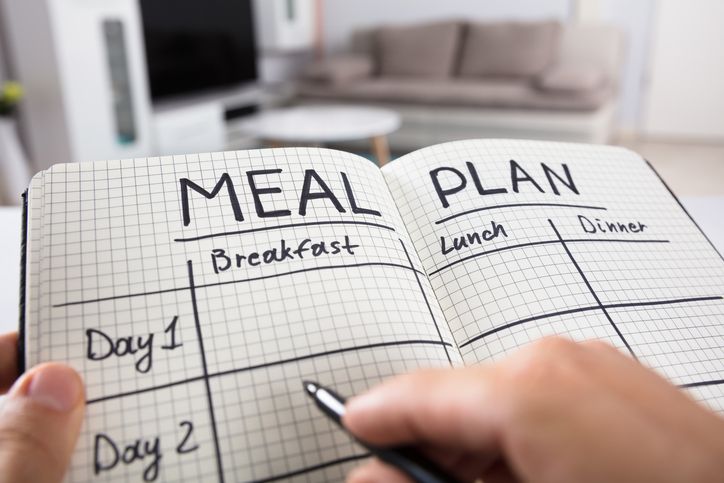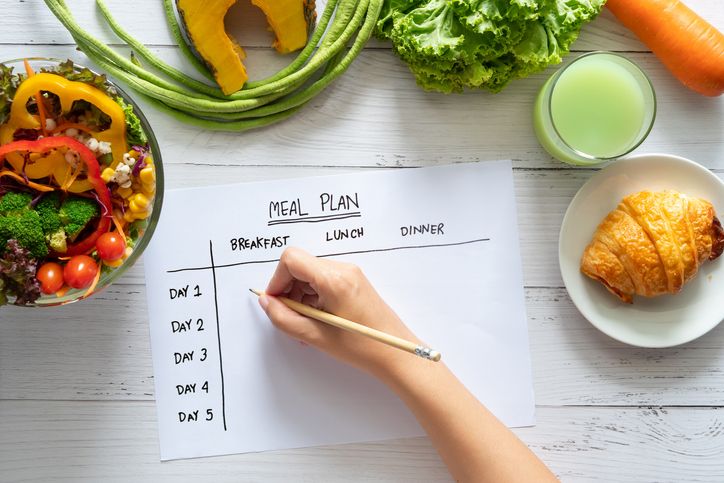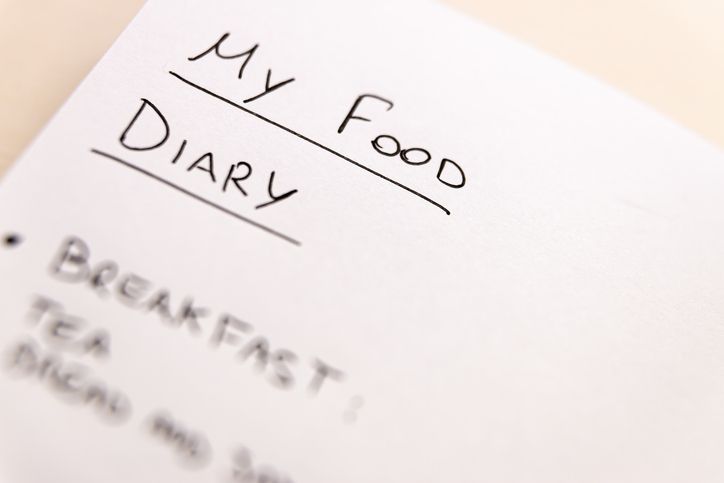
Author: Natalie Ng|Updated: 29 April 2025
Keeping a balanced eating routine doesn’t have to be complicated. Simple habits like planning meals, making smart shopping lists, and prepping food in advance can help you stay on track—even on busy days. It’s not about cutting everything out. It’s about including more of the good stuff—fruit and vegetables, whole grains like brown rice and wholemeal bread, lean meat, healthy fats like olive oil, and fewer processed foods, trans fats, and added sugar. A healthy diet gives your body all the nutrients it needs, supports a healthy weight, and lowers the risk of things like heart disease and weight gain. Swapping white rice for whole grains or choosing unsaturated fats over saturated fat makes a real difference. Want to eat well without overthinking it? Keep reading for easy tips to build balanced meals and make better food choices without the stress.

Plan Your Meals in Advance

Start with a Simple Weekly Plan
Pick one day each week—like Sunday—to plan out your meals. Think about your schedule, how busy each day looks, and when you’ll have time to cook. Include all the meals you’ll need, from breakfast to dinner.
Write a Shopping List
Once you know what you’re cooking, write a shopping list based on your plan. This helps you avoid impulse buys like processed foods or snacks high in added sugar. You’re more likely to buy healthy foods like brown rice, lean meat, fruit and vegetables, low fat milk, or dairy alternatives when you shop with a list.
Prep in Batches
Cook some foods in advance to save time during the week. Make a batch of cooked rice, cooked vegetables, or whole wheat pasta. Prepping basics like these means you can mix and match to build balanced meals quickly.
Keep It Flexible
Meal planning doesn’t mean you need to follow a strict routine. Keep some healthy, quick options around like frozen fruit, canned beans, or dried fruit. That way, you’re still eating healthily even if plans change.
By planning ahead, you’ll eat more balanced meals, include all the nutrients your body needs, and avoid last-minute choices that lead to more calories, too much salt, or unhealthy fats.

Create a Realistic Shopping Strategy

Building a healthy diet starts with how you shop. A smart grocery plan helps you follow a balanced eating routine and avoids common traps like impulse buys or relying on processed foods. With a little planning, your trips to the store can support your goals and save time and money.
Plan Weekly Grocery Lists
A clear shopping list keeps you focused and makes balanced meals easier to prepare. Start by checking your fridge and pantry. Avoid buying items you already have and make space for fresh ingredients.
Write down what you’ll need for the week based on your planned meals. Include all the food groups: fruit and vegetables, lean meat or other proteins, healthy fats like olive oil or canola oil, whole grains like brown rice or wholemeal bread, and dairy foods or dairy alternatives.
Break the list into sections like produce, frozen foods, pantry staples, and chilled items. This helps you move through the store faster and skip less healthy options that lead to weight gain or too much salt. Add healthy snacks like dried fruit, low fat milk, or unsalted nuts so you’re not tempted by processed snacks later.
Keep an ongoing list on your phone or a kitchen notepad to track what you’re running out of. This makes your shopping trips quicker and supports more consistent healthy eating.
Shop During Off-Hours
The time you shop matters. Busy stores make it harder to stay focused, especially if you’re tired or rushed. Try shopping early in the morning or later in the evening—before 10 AM or after 7 PM—when stores are quieter. You'll have more space and time to read labels and compare options.
Mid-week days like Tuesday or Wednesday are ideal because shelves are usually restocked and fresh produce is available. If you work regular hours, try going during a lunch break. It’s often less crowded and lets you avoid the after-work rush.
These simple shifts in timing help you stick to your list, choose better ingredients, and feel more relaxed during the process—all of which support a more balanced diet and long-term healthy habits.
Read More
Book Now to Experience
S6 Body Sculpting Treatment
1 Minute Self-Registration
Date should not be before minimal date

Master Simple Food Preparation Techniques

Knowing your way around basic food prep can make healthy eating feel easier and less time-consuming. You don’t need to be a chef to build balanced meals—just focus on a few simple skills that help you cook with confidence and consistency.
Learn Basic Knife Skills
Start with the basics: chopping, slicing, and dicing. Knowing how to safely cut fruit and vegetables helps you prep faster and reduces food waste. Good knife skills also make it easier to eat a variety of foods, like adding more cooked vegetables or a green salad to your plate.
Use the Right Cooking Methods
How you cook your food matters. Skip deep frying, which adds unhealthy trans fats and too many calories. Instead, try sautéing in a small amount of olive oil, steaming to keep in nutrients, or roasting with vegetable oils like canola oil or soybean oil.
These methods help you enjoy healthier meals without losing flavour. You’ll also preserve essential vitamins and reduce the risk of developing heart disease linked to high intake of saturated fat and processed foods.
Measure for Balance
Use simple measuring tools when needed—like a cup for rice or a tablespoon for oil. This helps you manage portion sizes and avoid overeating, especially if you're trying to lose weight or prevent weight gain. It also makes it easier to maintain a well balanced diet with all the nutrients your body needs.
Store Food Properly
Keep cooked rice, whole grains, or cooked vegetables in airtight containers to extend freshness. Label leftovers with dates and use them within a few days. Proper storage helps reduce food waste and keeps healthy foods ready for quick meals when you’re short on time.
By mastering these simple prep techniques, you’ll make healthy eating part of your routine—without spending hours in the kitchen.

Build Flexibility Into Your Eating Schedule

A consistent eating routine helps with balanced nutrition, but life doesn’t always go according to plan. Building in flexibility makes it easier to stick to your goals without feeling restricted or overwhelmed. This way, you can eat well while still enjoying your day-to-day life.
Plan Weekly Eating Windows
Instead of following a strict eating schedule, try setting flexible time blocks for meals. For example, plan breakfast between 7–9 AM, lunch between 12–2 PM, and dinner between 6–8 PM. These 2–3 hour windows allow you to adjust based on your day without skipping meals or eating too late.
Look at your weekly schedule and note any changes—like work shifts, appointments, or travel. This helps you plan balanced meals ahead of time and avoid quick fixes like processed foods or takeout that’s high in saturated fat or added sugar.
Allow for Special Occasions
A balanced eating routine doesn’t mean avoiding social events. If you have a dinner, party, or celebration, shift your eating window earlier or later to fit it in. You might have a lighter lunch if you know dinner will be heavier, or plan extra fruit and vegetables earlier in the day.
Eating healthily long-term includes space for occasional treats and meals that look different from your usual routine. It’s the overall pattern that matters—not one meal.
Create Back-Up Meal Options
Sometimes plans change last minute. Having backup options makes it easier to stay on track without stress. Keep frozen fruit, canned beans, or lean protein like tuna on hand. Store pre-cut vegetables or leftover whole wheat pasta in the fridge for quick, healthy meals.
A few shelf-stable items like wholemeal bread, dried fruit, or unsweetened fruit juice can fill gaps when you’re short on time. These backup options support your healthy plate goals and help you avoid skipping meals or turning to refined grains or processed meat in a pinch.
Staying flexible keeps your routine realistic, which makes it easier to maintain balanced meals and support good health long-term.
Book Now to Experience
S6 Body Sculpting Treatment
1 Minute Self-Registration
Date should not be before minimal date

Prepare For Social Events and Dining Out

Eating healthily isn’t just about what you do at home. Social events and restaurant meals are part of life, and you can enjoy them without throwing off your balanced eating routine. A little planning helps you make choices that support your goals—while still enjoying the moment.
Check Menus in Advance
If you’re going out to eat, look up the menu beforehand. Choose dishes that include a mix of different foods—like lean meat, oily fish, whole grains, or a green salad. Avoid meals loaded with saturated fat or trans fats by skipping deep-fried options and creamy sauces.
Look for grilled, steamed, or roasted items. Ask for olive oil or dressing on the side and swap out fries for cooked vegetables or brown rice. Most restaurants are used to simple requests like extra veggies or smaller portions.
Eat Before the Event if Needed
If you're heading to a gathering where food choices might be limited, have a small snack first. A handful of nuts, a boiled egg, or a piece of fruit helps control hunger so you’re not tempted to overeat when you arrive. This is especially helpful if you're trying to lose weight or avoid more calories from processed foods or sugary snacks.
Be Smart About Portions
At restaurants or events, portion sizes are often bigger than you need. Share a main dish, order a side instead of a full meal, or ask for half to be packed to go before you start eating. These small changes can help you manage intake and keep your balanced diet on track.
Focus on Balance, Not Perfection
Social meals don’t have to be “perfect.” Aim to fill half your plate with vegetables or salad, add a source of protein like lean meat or beans, and include a whole grain if available. Try to limit high-sugar drinks and go for water or unsweetened options when you can.
These simple habits make it easier to enjoy yourself while still supporting your healthy weight and balanced nutrition goals.

Develop Healthy Stress Management Habits

Stress can disrupt your balanced eating routine without you even noticing. It often leads to emotional eating, cravings for high-fat or high-sugar foods, and skipped meals. Managing stress in simple, realistic ways helps you stick to a healthy diet and avoid falling into patterns that can lead to weight gain or poor nutrition.
Recognise How Stress Affects Your Eating
When you're under stress, your body often craves foods that are high in saturated fat, added sugar, or refined grains. These may offer short-term comfort, but they don’t support balanced nutrition or long-term health. This can lead to poor food choices and an increase in processed foods, which are linked to developing heart disease and chronic disease.
Being aware of this connection helps you catch the pattern early and choose healthier ways to cope.
Move Your Body
Regular movement helps reduce stress and supports a healthy weight. You don’t need intense workouts—simple activities like walking, stretching, or light exercise regularly can help improve your mood and lower tension. Over time, this also makes it easier to maintain healthy eating habits.
Set Clear Boundaries
Stress from work or other responsibilities can spill over into your eating habits. Set small boundaries to protect your time and energy—for example, turning off work emails at a certain time or planning your meals in advance so you’re not deciding what to eat when you’re already overwhelmed.
Express Yourself in Healthy Ways
Instead of turning to food, try quick methods to handle emotions. Jot down your thoughts in a journal, talk with a friend, or take a short walk. These actions can break the cycle of emotional eating and help you stay focused on balanced meals that include all the nutrients your body needs.
By managing stress in healthy ways, you’ll find it easier to stay consistent with your healthy plate, avoid too much salt or added sugar, and support your overall goal of maintaining good health.
Book Now to Experience
S6 Body Sculpting Treatment
1 Minute Self-Registration
Date should not be before minimal date

Track Your Progress and Adjust Your Approach

Staying consistent with a balanced eating routine isn’t just about what you eat—it’s also about noticing how your choices affect you over time. Tracking simple things like meals, energy levels, or how your body feels can help you spot patterns and make better decisions going forward.
Keep a Food Journal
Writing down what you eat each day helps you stay aware of your habits. You can track your meals, snacks, drinks, and note how you felt afterward. Did you feel full? Sluggish? Energised? Over time, this helps you see how different foods affect your mood, energy, and overall health.
You’ll also notice if certain foods—like processed meat, full fat dairy products, or meals high in added sugar—are showing up too often. This makes it easier to swap them for healthier options like lean meat, whole grains, or unsaturated fats.
Monitor Simple Body Signals
You don’t need complicated tools to track your progress. Rate your energy on a scale from 1 to 10, or take note of when you feel bloated, tired, or extra focused. If a certain type of food or eating pattern helps you feel better, try to include more of that in your routine.
Weighing yourself weekly or checking how your clothes fit can also give you a sense of whether you're maintaining a healthy weight—but avoid obsessing over small changes.
Make Small Adjustments
If something isn’t working—maybe a certain meal leaves you hungry, or you feel tired in the afternoon—make small changes. Try increasing your protein, adding more fruit and vegetables, or cutting back on refined grains and saturated fat.
Balanced meals aren’t one-size-fits-all. You might need more healthy fats, fewer calories, or a better balance of food groups depending on your lifestyle.
Tracking helps you eat more intentionally, reduce mindless habits, and build a well balanced diet that supports long-term, good health.

Support Your Balanced Eating Routine With S6 Body Sculpting Treatment
Even with a well balanced diet and consistent healthy meals, some areas of body fat can be hard to lose—especially around the belly, thighs, or back. That’s where S6 Body Sculpting Treatment comes in. This non-invasive treatment is designed to complement your balanced eating routine by helping reduce stubborn fat and firm up the skin without the need for surgery, medication, or downtime.
How S6 Body Sculpting Works
The treatment uses a low-energy bio-laser that targets subcutaneous fat in specific areas of the body. The laser energy breaks down fat cells, releasing fatty acids that are then cleared through the lymphatic system. A built-in vacuum suction gently massages the treatment area, boosting metabolism and encouraging fat drainage.
At the same time, the laser stimulates collagen production, which helps tighten the skin and reduce the appearance of sagging after fat loss. This makes it easier to maintain a sculpted shape, especially if you’re already following a healthy diet and working to maintain a healthy weight.
How It Supports Balanced Eating and a Healthy Lifestyle
Eating healthily and following a balanced eating routine lays the foundation for good health, but sometimes, even when you're doing everything right—choosing lean meat, whole grains, fruit and vegetables, and avoiding processed foods—you may still struggle with fat in specific areas.
S6 Body Sculpting is not a replacement for healthy eating or exercise, but it can support your goals by enhancing visible results in areas that are difficult to target with diet alone. Whether it’s fat around the waist, thighs, or under the arms, the treatment offers a focused solution while you continue to eat balanced meals and stay active.
Benefits of the S6 Body Sculpting Treatment
• Targets stubborn fat in seven areas: belly, waist, arms, thighs, calves, buttocks, and back
• Non-surgical and non-invasive – no needles, no medication, no downtime
• Stimulates collagen for a tightening effect, avoiding saggy skin after fat loss
• Boosts metabolic rate and supports your body’s natural fat drainage
• Comfortable sessions with most people able to return to daily activities right after
If you're already making smart food choices—cutting back on trans fats, too much salt, or refined grains, and including more healthy fats like olive oil, canola oil, or dairy alternatives—S6 can help bring your efforts full circle.
Ready to See Results?
Book your S6 Body Sculpting session today and support your balanced eating routine with a treatment that helps your body look as healthy as it feels.
New Beauty's S6 Body Sculpting TreatmentBook Now to Experience
S6 Body Sculpting Treatment
1 Minute Self-Registration
Date should not be before minimal date
FAQ
How Long Does It Typically Take to Form New Eating Habits?
You'll typically need 21 to 66 days to form new eating habits, with most people averaging around 66 days for the behavior to become automatic. Don't feel discouraged if it takes longer - everyone's journey differs. Your brain needs time to rewire and create new neural pathways. Focus on small, consistent changes rather than drastic overhauls to make the shift more sustainable and empowering.
What Role Do Supplements Play in Maintaining a Balanced Diet?
Supplements shouldn't be your first line of defense - they're meant to complement, not replace, a balanced diet. While you can't out-supplement poor eating habits, certain nutrients might need boosting if you're dealing with specific deficiencies or dietary restrictions. Focus on getting nutrients from whole foods first, and consult a healthcare provider to determine if you need targeted supplementation based on your unique needs, lifestyle, and blood work.
Should I Eat Differently on Workout Days Versus Rest Days?
You'll need to adjust your calories and macronutrients based on your activity level. On workout days, increase your carbohydrate and protein intake to fuel performance and support muscle recovery. On rest days, you can slightly reduce your carbs while maintaining protein levels. Don't cut calories drastically on rest days - your body's still recovering and rebuilding. Listen to your hunger cues and adjust portions naturally.
How Can I Maintain Portion Control When Eating Healthy but Calorie-Dense Foods?
You can't have your cake and eat it too when it comes to calorie-dense healthy foods. Keep nuts, seeds, and avocados in check by pre-portioning them into small containers. Use measuring tools until you train your eye to recognize proper serving sizes. Try mixing these foods with lower-calorie options - add nuts to salads or spread avocado thinly on toast rather than eating them alone.
What Are the Signs That My Balanced Eating Routine Isn't Working?
You'll notice key signs when your eating routine needs adjustment: constant fatigue, irregular hunger patterns, mood swings, or difficulty concentrating. If you're experiencing digestive issues, intense cravings, or disrupted sleep, your body's telling you something's off. Watch for unexplained weight changes, decreased workout performance, or feeling obsessed with food choices. Don't ignore physical or emotional discomfort - they're signals to reassess your approach.
Recommended Articles
COPYRIGHT© NEW BEAUTY MANAGEMENT LIMITED 2025. ALL RIGHT RESERVED.




